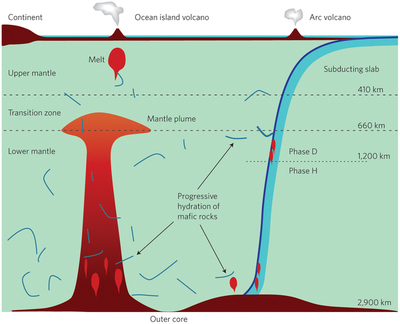Research Highlights
Hunting for a hidden ocean
Studies indicate that reservoirs of water inside Earth's rocky mantle may exist deeper than previously imagined
Scientists have found the probable location of an ocean's worth of water within the Earth's interior1,2. The researchers at the Earth-Life Science Institute (ELSI) analyzed seismic waves and used diamond 'anvils' that squeeze rocks to unimaginable pressures to pinpoint the region within the Earth's interior.
For a long time, researchers believed our planet started as a very dry world, with oceans appearing only through collisions with comets and asteroids. Recent analysis of minerals in the mantle and core, however, revealed enough water to fill the planet, potentially many times over. Along the 'ring of fire' basin where tectonic plates carry ocean water deep underground, seismologists are trying to identify these hydrated deposits.
Initial reports indicated the 'transition zone' region 410 to 660 kilometers below the surface may contain a hidden reservoir. The magnesium-silicate minerals in the zone have crystal structures that can hold substantial volumes of water -- an estimated ten oceans' worth. But questions exist on how water gets to these depths, and whether it returns to the surface.
"If you were able to carry water with that mineral phase into the transition zone, it's not clear whether it would stay there," says ELSI's Christine Houser. "We don't know how much water is stored in the mantle, and whether it's one or ten oceans makes a big difference to planetary formation models."
Houser is using seismic images to show that tectonic plates pass through the transition zone into the lower mantle while warm material rises to the surface at hot spots. Any water caught in the rock circulating through Earth will likely end up trapped in the transition zone, instead of the upper or lower mantle.
While Houser uses seismology to search for transition zone water, her colleague Jun Tsuchiya at ELSI recently discovered a mineral phase that may carry water even deeper. She used first principles computations based on quantum mechanics to simulate minerals under high pressure conditions and spotted a new magnesium silicate mineral that could hold water in the lower mantle -- an unexpected home for an ocean-full of water. The findings were published in Geophysical Research Letters.
Another ELSI researcher, Masayuki Nishi, confirmed the existence of this new hydrous mineral reported by Tsuchiya using multi-anvil apparatus in his laboratory. He suggested that significant amounts of water were retained in this mineral, which descended to staggering depths more than 1250 kilometers below Earth's surface. His research has been published in Nature Geoscience.
"The questions now are what are the seismic signatures of this potential lower mantle phase, and how do we look for them," adds Houser.
In the deep water cycle, a subducting slab transports water from the surface into Earth's mantle in the form of hydrated minerals. The water can return to the surface through volcano activity. Credit: Reprinted by permission from Macmillan Publishers Ltd: Nature Geoscience (ref3), copyright (2015).
Reference:
-
Tsuchiya, J. First principles prediction of a new high-pressure phase of dense
hydrous magnesium silicates in the lower mantle. Geophysical Research Letters 40, 4570-4573 (2013). doi:10.1002/grl.50875 -
Nishi, M., Irifune, T., Tsuchiya, J., Tange, Y., Nishihara, Y., Fujino, K. & Higo, Y. Stability of hydrous silicate at high pressures and water transport to the deep lower mantle. Nature Geoscience 7, 224-227 (2014). doi:10.1038/NGEO2074
-
Nishi.M. Deep water cycle: Mantle hydration. Nature Geoscience 8, 9-10 (2015) doi:10.1038/ngeo2326













